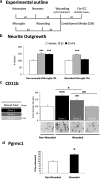Progesterone antagonism of neurite outgrowth depends on microglial activation via Pgrmc1/S2R
- PMID: 23653459
- PMCID: PMC3689281
- DOI: 10.1210/en.2012-2109
Progesterone antagonism of neurite outgrowth depends on microglial activation via Pgrmc1/S2R
Abstract
Neuronal plasticity is regulated by the ovarian steroids estradiol (E2) and progesterone (P4) in many normal brain functions, as well as in acute response to injury and chronic neurodegenerative disease. In a female rat model of axotomy, the E2-dependent compensatory neuronal sprouting is antagonized by P4. To resolve complex glial-neuronal cell interactions, we used the "wounding-in-a-dish" model of neurons cocultured with astrocytes or mixed glia (microglia to astrocytes, 1:3). Although both astrocytes and mixed glia supported E2-enhanced neurite outgrowth, P4 antagonized E2-induced neurite outgrowth only with mixed glia, but not astrocytes alone. We now show that P4-E2 antagonism of neurite outgrowth is mediated by microglial expression of progesterone receptor (Pgr) membrane component 1 (Pgrmc1)/S2R, a putative nonclassical Pgr mediator with multiple functions. The P4-E2 antagonism of neurite outgrowth was restored by add-back of microglia to astrocyte-neuron cocultures. Because microglia do not express the classical Pgr, we examined the role of Pgrmc1, which is expressed in microglia in vitro and in vivo. Knockdown by siRNA-Pgrmc1 in microglia before add-back to astrocyte-neuron cocultures suppressed the P4-E2 antagonism of neurite outgrowth. Conditioned media from microglia restored the P4-E2 activity, but only if microglia were activated by lipopolysaccharide or by wounding. Moreover, the microglial activation was blocked by Pgmrc1-siRNA knockdown. These findings explain why nonwounded cultures without microglial activation lack P4 antagonism of E2-induced neurite outgrowth. We suggest that microglial activation may influence brain responses to exogenous P4, which is a prospective therapy in traumatic brain injury.
Figures








Similar articles
-
Progesterone influence on neurite outgrowth involves microglia.Endocrinology. 2009 Jan;150(1):324-32. doi: 10.1210/en.2008-0988. Epub 2008 Sep 4. Endocrinology. 2009. PMID: 18772232 Free PMC article.
-
Differential responses of progesterone receptor membrane component-1 (Pgrmc1) and the classical progesterone receptor (Pgr) to 17β-estradiol and progesterone in hippocampal subregions that support synaptic remodeling and neurogenesis.Endocrinology. 2012 Feb;153(2):759-69. doi: 10.1210/en.2011-1699. Epub 2011 Dec 6. Endocrinology. 2012. PMID: 22147012 Free PMC article.
-
Progesterone increases the release of brain-derived neurotrophic factor from glia via progesterone receptor membrane component 1 (Pgrmc1)-dependent ERK5 signaling.Endocrinology. 2012 Sep;153(9):4389-400. doi: 10.1210/en.2011-2177. Epub 2012 Jul 9. Endocrinology. 2012. PMID: 22778217 Free PMC article.
-
Non-canonical progesterone signaling in granulosa cell function.Reproduction. 2014 Apr 8;147(5):R169-78. doi: 10.1530/REP-13-0582. Print 2014 May. Reproduction. 2014. PMID: 24516175 Free PMC article. Review.
-
Neurite outgrowth inhibitors in gliotic tissue.Adv Exp Med Biol. 1999;468:207-24. doi: 10.1007/978-1-4615-4685-6_17. Adv Exp Med Biol. 1999. PMID: 10635031 Review.
Cited by
-
Chromosomal and gonadal factors regulate microglial sex effects in the aging brain.Brain Res Bull. 2023 Apr;195:157-171. doi: 10.1016/j.brainresbull.2023.02.008. Epub 2023 Feb 15. Brain Res Bull. 2023. PMID: 36804773 Free PMC article. Review.
-
Sigma Receptors as Endoplasmic Reticulum Stress "Gatekeepers" and their Modulators as Emerging New Weapons in the Fight Against Cancer.Front Pharmacol. 2018 Jul 10;9:711. doi: 10.3389/fphar.2018.00711. eCollection 2018. Front Pharmacol. 2018. PMID: 30042674 Free PMC article. Review.
-
Expression of Progesterone Receptor Membrane Component 1 (PGRMC1), Progestin and AdipoQ Receptor 7 (PAQPR7), and Plasminogen Activator Inhibitor 1 RNA-Binding Protein (PAIRBP1) in Glioma Spheroids In Vitro.Biomed Res Int. 2016;2016:8065830. doi: 10.1155/2016/8065830. Epub 2016 Jun 1. Biomed Res Int. 2016. PMID: 27340667 Free PMC article.
-
Neurosteroids, Microbiota, and Neuroinflammation: Mechanistic Insights and Therapeutic Perspectives.Int J Mol Sci. 2025 Jul 21;26(14):7023. doi: 10.3390/ijms26147023. Int J Mol Sci. 2025. PMID: 40725270 Free PMC article. Review.
-
PGRMC1 Promotes Progestin-Dependent Proliferation of Breast Cancer Cells by Binding Prohibitins Resulting in Activation of ERα Signaling.Cancers (Basel). 2021 Nov 11;13(22):5635. doi: 10.3390/cancers13225635. Cancers (Basel). 2021. PMID: 34830790 Free PMC article.
References
-
- Woolley CS, McEwen BS. Roles of estradiol and progesterone in regulation of hippocampal dendritic spine density during the estrous cycle in the rat. J Comp Neurol. 1993;336:293–306 - PubMed
-
- Sierra A, Gottfried-Blackmore A, Milner TA, McEwen BS, Bulloch K. Steroid hormone receptor expression and function in microglia. Glia. 2008;56:659–674 - PubMed
Publication types
MeSH terms
Substances
Grants and funding
LinkOut - more resources
Full Text Sources
Other Literature Sources
Research Materials

